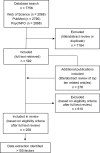Contributions of a Child's Built, Natural, and Social Environments to Their General Cognitive Ability: A Systematic Scoping Review
- PMID: 26840411
- PMCID: PMC4739499
- DOI: 10.1371/journal.pone.0147741
Contributions of a Child's Built, Natural, and Social Environments to Their General Cognitive Ability: A Systematic Scoping Review
Abstract
The etiology of a child's cognitive ability is complex, with research suggesting that it is not attributed to a single determinant or even a defined period of exposure. Rather, cognitive development is the product of cumulative interactions with the environment, both negative and positive, over the life course. The aim of this systematic scoping review was to collate evidence associated with children's cognitive health, including inherent factors as well as chemical and non-chemical stressors from the built, natural, and social environments. Three databases were used to identify recent epidemiological studies (2003-2013) that examined exposure factors associated with general cognitive ability in children. Over 100 factors were evaluated from 258 eligible studies. We found that recent literature mainly assessed the hypothesized negative effects of either inherent factors or chemical exposures present in the physical environment. Prenatal growth, sleep health, lead and water pollutants showed consistent negative effects. Of the few studies that examined social stressors, results consistently showed cognitive development to be influenced by both positive and negative social interactions at home, in school or the community. Among behavioral factors related to diet and lifestyle choices of the mother, breastfeeding was the most studied, showing consistent positive associations with cognitive ability. There were mostly inconsistent results for both chemical and non-chemical stressors. The majority of studies utilized traditional exposure assessments, evaluating chemical and non-chemical stressors separately. Collective evidence from a limited number of studies revealed that cumulative exposure assessment that incorporates multiple chemical and non-chemical stressors over the life course may unravel the variability in effect on cognitive development and help explain the inconsistencies across studies. Future research examining the interactions of multiple stressors within a child's total environment, depicting a more real-world exposure, will aid in understanding the cumulative effects associated with a child's ability to learn.
Conflict of interest statement
Figures



Similar articles
-
A Meta-Analysis of Stressors from the Total Environment Associated with Children's General Cognitive Ability.Int J Environ Res Public Health. 2020 Jul 29;17(15):5451. doi: 10.3390/ijerph17155451. Int J Environ Res Public Health. 2020. PMID: 32751096 Free PMC article.
-
State-of-the-Science Review of Non-Chemical Stressors Found in a Child's Social Environment.Int J Environ Res Public Health. 2019 Nov 11;16(22):4417. doi: 10.3390/ijerph16224417. Int J Environ Res Public Health. 2019. PMID: 31718056 Free PMC article. Review.
-
Chemical and non-chemical stressors affecting childhood obesity: a systematic scoping review.J Expo Sci Environ Epidemiol. 2018 Jan;28(1):1-12. doi: 10.1038/jes.2017.18. Epub 2017 Sep 27. J Expo Sci Environ Epidemiol. 2018. PMID: 28952603 Free PMC article.
-
The Combined Influence of Air Pollution and Home Learning Environment on Early Cognitive Skills in Children.Int J Environ Res Public Health. 2017 Oct 26;14(11):1295. doi: 10.3390/ijerph14111295. Int J Environ Res Public Health. 2017. PMID: 29072589 Free PMC article.
-
Review of built and natural environment stressors impacting American-Indian/Alaska-Native children.Rev Environ Health. 2018 Dec 19;33(4):349-381. doi: 10.1515/reveh-2018-0034. Rev Environ Health. 2018. PMID: 30205649 Free PMC article. Review.
Cited by
-
Development and Maturation of the Human Brain, from Infancy to Adolescence.Curr Top Behav Neurosci. 2024;68:327-348. doi: 10.1007/7854_2024_514. Curr Top Behav Neurosci. 2024. PMID: 39138744 Review.
-
Exposure to Perfluorinated Alkyl Substances and Health Outcomes in Children: A Systematic Review of the Epidemiologic Literature.Int J Environ Res Public Health. 2017 Jun 27;14(7):691. doi: 10.3390/ijerph14070691. Int J Environ Res Public Health. 2017. PMID: 28654008 Free PMC article.
-
Animal-sourced foods for improved cognitive development.Anim Front. 2019 Sep 28;9(4):50-57. doi: 10.1093/af/vfz039. eCollection 2019 Oct. Anim Front. 2019. PMID: 32002274 Free PMC article. No abstract available.
-
The Role of Environmental Chemicals in the Etiology of Learning Difficulties: A Novel Theoretical Framework.Mind Brain Educ. 2023 Nov;17(4):301-311. doi: 10.1111/mbe.12354. Epub 2023 Apr 11. Mind Brain Educ. 2023. PMID: 38389544 Free PMC article.
-
Prenatal drug exposure and executive function in early adolescence.Neurotoxicol Teratol. 2021 Nov-Dec;88:107036. doi: 10.1016/j.ntt.2021.107036. Epub 2021 Oct 11. Neurotoxicol Teratol. 2021. PMID: 34648914 Free PMC article.
References
-
- Chambers B, Cheung A, Slavin R, Smith D, Laurenzano M. Effective early childhood education programs: a systematic review. Baltimore: Johns Hopkins University, Center for Research and Reform in Education; 2010.
-
- Aratani Y, Wight V, Cooper J. Racial gaps in early childhood: socio-emotional health, developmental and educational outcomes among African-American boys New York: Columbia University, National Center for Children in Poverty; 2011.
-
- Reardon S. The widening academic achievement gap between rich and poor: new evidence and possible explanations In: Duncan GJ, Murnane RJ, editors. Whither opportunity? Rising inequality, schools, and children's life chances. New York: Russel Sage Foundation; 2011; p. 91–115.
Publication types
MeSH terms
LinkOut - more resources
Full Text Sources
Other Literature Sources
Medical

